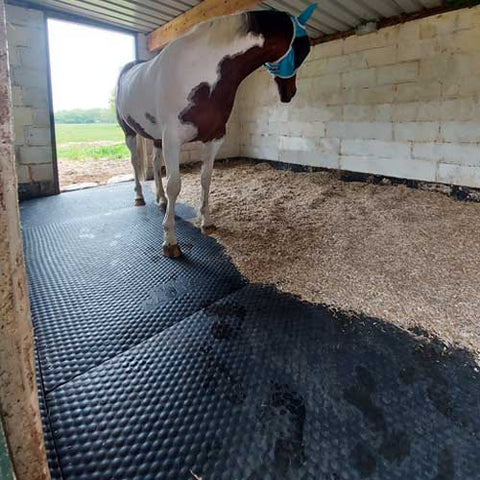
Horse rubber mats are essential for providing comfort, safety, and hygiene in stables, horse trailers, wash bays, and other equestrian facilities. Regular cleaning is crucial to maintaining their longevity, preventing odor buildup, and ensuring a healthier environment for horses. This article explores the best practices for cleaning horse rubber mats effectively.
Why Regular Cleaning is Important
Horse rubber mats collect dirt, manure, urine, and bacteria over time. Without routine maintenance, they can become a breeding ground for harmful pathogens, leading to respiratory and hoof-related health issues for horses. Additionally, dirty mats can emit unpleasant odors, making the stable environment uncomfortable for both horses and caretakers. Regular cleaning ensures a sanitary and slip-resistant surface, improving the overall functionality of the mats.
Step-by-Step Guide to Cleaning Horse Rubber Mats
1. Gather Necessary Cleaning Supplies
Before starting the cleaning process, having the right tools and products is essential. You will need:
-
A stiff-bristled broom or brush
-
A hose with a high-pressure nozzle
-
Mild detergent or equine-safe disinfectant
-
A scraper or shovel (for removing solid waste)
-
Rubber gloves
-
A squeegee (optional, for drying)
2. Remove Debris and Loose Dirt
Start by sweeping or scraping off any solid debris such as manure, hay, and dirt. A shovel or a sturdy broom works well for this step. If the mats are used in high-traffic areas like horse walkways, they may accumulate more debris and require extra attention during this stage.
3. Remove and Inspect the Mats
If possible, remove the mats from their location and place them on a flat, clean surface for more thorough cleaning. Inspect them for damage such as cracks, curling edges, or excessive wear. Damaged mats should be replaced or repaired to maintain safety and durability.
4. Scrub with Water and Detergent
Use a hose with a high-pressure nozzle to rinse the mats, loosening stuck-on grime. Then, apply a mild detergent or an equine-safe disinfectant to break down organic matter and bacteria. Scrub thoroughly with a stiff-bristled brush to remove embedded dirt and stains. Pay extra attention to areas exposed to urine, as ammonia buildup can lead to strong odors and bacterial growth.
5. Rinse Thoroughly
After scrubbing, rinse the mats thoroughly to remove any soap or cleaning solution. Residual chemicals can cause irritation to a horse’s hooves and skin. Ensure all cleaning agents are washed away, leaving the mats clean and residue-free.
6. Dry the Mats Properly
Allow the mats to air dry completely before reinstalling them. If time is limited, use a squeegee to remove excess water and speed up the drying process. Proper drying prevents mold and mildew growth, which can create slippery and hazardous conditions.
7. Disinfect and Deodorize (Optional)
For extra sanitation, especially in areas where multiple horses come into contact with the mats, consider using an equine-safe disinfectant. This helps kill bacteria and reduces odor buildup. Sprinkling baking soda or using specialized odor-neutralizing products can further enhance freshness.
Maintenance Tips for Long-Term Durability
Regular Cleaning Schedule
To maintain hygiene, establish a consistent cleaning routine based on usage. For high-traffic areas such as horse walkways, cleaning may be required daily, while less frequently used mats can be cleaned weekly.
Proper Storage and Handling
If mats need to be removed and stored for seasonal use, ensure they are clean and dry before stacking them. Store in a well-ventilated area to prevent mold and odor buildup.
Monitor for Damage and Replace When Necessary
Horse rubber mats undergo constant wear and tear. Regularly inspect them for cracks, uneven surfaces, or loss of traction. Damaged mats should be replaced promptly to avoid safety hazards.
Special Considerations for Different Types of Mats
Horse Shower Mats
Mats used in wash bays are exposed to constant moisture and require more frequent cleaning to prevent mold and mildew. Using a non-slip mat specifically designed for wet areas improves safety and reduces maintenance efforts.
Horse Walkway Mats
These mats endure heavy foot traffic and often accumulate dirt quickly. Regular sweeping and periodic deep cleaning are necessary to prevent excessive buildup and maintain a safe walking surface.
Choosing High-Quality Mats for Easier Maintenance
Investing in high-quality mats from reputable horse rubber mats manufacturers ensures durability and ease of cleaning. Quality mats resist wear, provide better drainage, and are less likely to retain odors. When purchasing mats, look for those with non-porous surfaces to prevent absorption of liquids and bacteria.
Conclusion
Cleaning horse rubber mats effectively requires a systematic approach that includes debris removal, thorough scrubbing, proper drying, and regular maintenance. By following best practices, stable owners can ensure a clean, safe, and comfortable environment for their horses. Proper care not only extends the lifespan of the mats but also promotes better hygiene and safety in equestrian spaces. Whether maintaining horse shower mats or horse walkway mats, a diligent cleaning routine is key to maximizing their benefits.